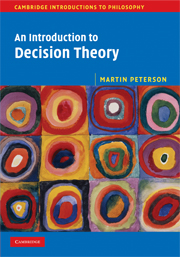Book contents
- Frontmatter
- Contents
- Preface
- 1 Introduction
- 2 The decision matrix
- 3 Decisions under ignorance
- 4 Decisions under risk
- 5 Utility
- 6 The mathematics of probability
- 7 The philosophy of probability
- 8 Why should we accept the preference axioms?
- 9 Causal vs. evidential decision theory
- 10 Bayesian vs. non-Bayesian decision theory
- 11 Game theory I: Basic concepts and zero-sum games
- 12 Game theory II: Nonzero-sum and cooperative games
- 13 Social choice theory
- 14 Overview of descriptive decision theory
- Appendix A Glossary
- Appendix B Proof of the von Neumann–Morgenstern theorem
- Further reading
- Index
14 - Overview of descriptive decision theory
- Frontmatter
- Contents
- Preface
- 1 Introduction
- 2 The decision matrix
- 3 Decisions under ignorance
- 4 Decisions under risk
- 5 Utility
- 6 The mathematics of probability
- 7 The philosophy of probability
- 8 Why should we accept the preference axioms?
- 9 Causal vs. evidential decision theory
- 10 Bayesian vs. non-Bayesian decision theory
- 11 Game theory I: Basic concepts and zero-sum games
- 12 Game theory II: Nonzero-sum and cooperative games
- 13 Social choice theory
- 14 Overview of descriptive decision theory
- Appendix A Glossary
- Appendix B Proof of the von Neumann–Morgenstern theorem
- Further reading
- Index
Summary
This chapter gives an overview of how people do actually make decisions. The headline news is that people frequently act in ways deemed to be irrational by decision theorists. This shows that people should either behave differently, or that there is something wrong with the normative theories discussed in the preceding chapters of this book. After having reviewed the empirical findings, both conclusions will be further considered.
The interest in descriptive decision theory arose in parallel with the development of normative theories. Given the enormous influence axiomatic theories had in the academic community in the latter half of the twentieth century, it became natural to test the axioms in empirical studies. Since many decision theorists advocate (some version of) the expected utility principle, it is hardly surprising that the axioms of expected utility theory are the most researched ones. Early studies cast substantial doubt on the expected utility principle as an accurate description of how people actually choose. However, it was not until 1979 and the publication of a famous paper by Kahneman and Tversky that it finally became widely accepted that expected utility theory is a false descriptive hypothesis. Kahneman and Tversky's paper has become one of the most frequently quoted academic publications of all times. (Kahneman was awarded the Nobel Prize in economics in 2002, but Tversky died a few years earlier.) In what follows, we shall summarise their findings, as well as some later observations.
- Type
- Chapter
- Information
- An Introduction to Decision Theory , pp. 285 - 295Publisher: Cambridge University PressPrint publication year: 2009

